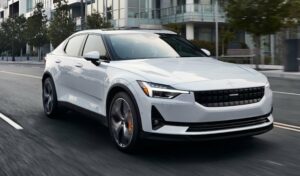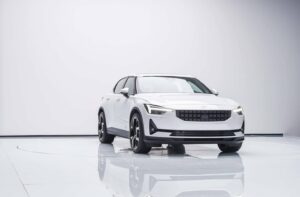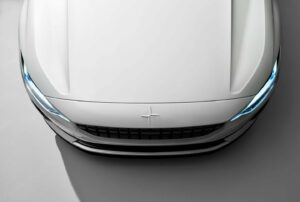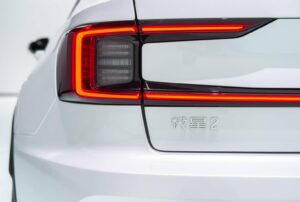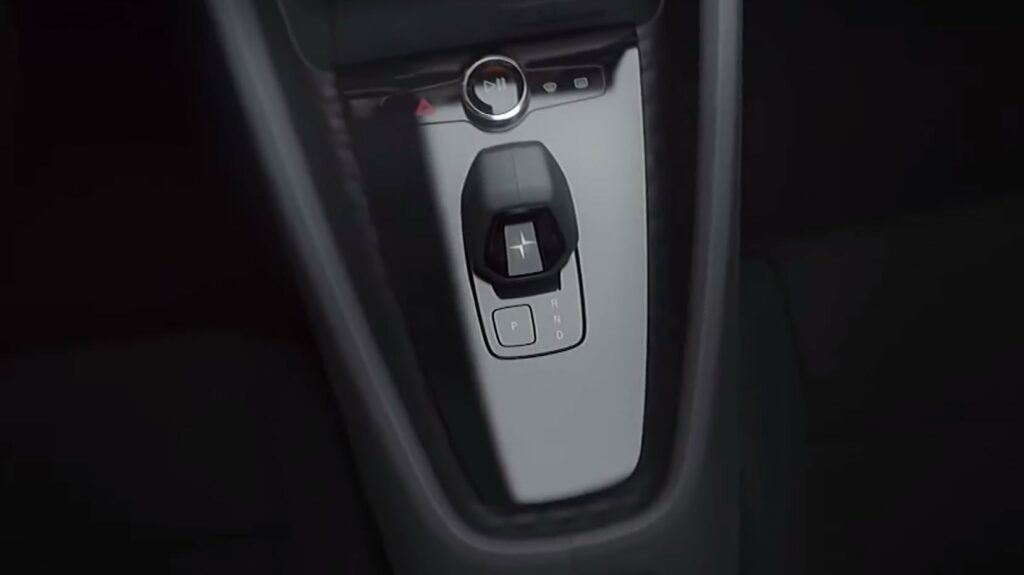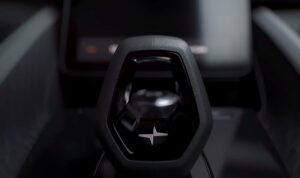Polestar 2 Long Range Dual Moto
Polestar 2 is a unique 5-door fastback with an original design, outstanding technical characteristics, and many innovative solutions.

The electric car is made with a fastback body, which gives it a lower drag coefficient and maximizes its aerodynamic characteristics. To improve aerodynamics all exterior components are designed, for example, frameless side mirrors, which not only reduce drag but also maximize the driver’s view. In general, the entire body has been designed so that the car expresses and embodies swiftness.
Of the original exterior elements, the adaptive taillights, in which the LED lights shine more intensely under hard and sharp braking, should be noted.
Another curiosity of the model is the projection of the Polestar 2 logo, which is displayed on the panoramic roof, quite an interesting touch to the self-identification. Also worth noting is the panoramic roof itself, which is made of laminated glass, so as to reduce the effects of solar radiation.

Inside the electric car gives a sense of comfort and spaciousness. It will not be cramped for people with any complexion, and a huge glass area forms an incredible perception of the huge interior volume.
The materials and colors of Polestar 2 have been selected with the utmost care. Basic “vegan” interior materials, decorative elements in black ash and reclaimed wood, textile panels, and optional Nappa leather are just some of the details that help you to create your own Polestar 2 interior.
Note the Polestar 2’s trunk door feature, which has a hinge at the top that allows it to open in 2 halves, giving you unlimited access to the entire trunk. The door itself has several options for opening:
via the Polestar Connect app;
by a button on the dashboard or on the door itself;
with a sensor under the bumper.
The trunk is huge and offers 404 liters of usable volume plus 34 liters in the front hood compartment.

Performance is the Polestar 2’s main feature, which is embodied in its outstanding drivetrain.
With a battery capacity of 78 kW⋅h (72 kW⋅h in China), EFAD + ERAD permanent magnet motors each with 150 kW and 330 N⋅m of torque (a combined 300 kW and 660 N⋅m), and a range of 500 km (WLTP)/442 km (EPA), Polestar 2 offers an incredible electric “power exhaust”, accelerating to the first 100 km/h in less than 5 seconds.
The Polestar 2’s battery pack is formed from 27 modules built into the floor. This layout gives the chassis greater stability and, together with Volvo’s Compact Modular Architecture (CMA) platform, reduces interior noise by an average of 3.7 dB compared to other vehicles.
Polestar 2 uses mixed braking, combining regenerative braking with conventional brakes to regenerate the maximum amount of power. This allows you to operate a single pedal with different levels of braking, which can be set up in the electric car or through the Polestar Connect app.

The electric car can be charged from a regular outlet and at fast charging stations with up to 150 kW of power. The electric car has a built-in 11kW charger, and the charging power, duration, and maximum charge level can be adjusted through the Polestar Connect app.
The car comes standard with a 7-meter AC charging cord (for conventional outlets).
The Polestar 2 is the first car equipped with built-in Google services, including Google Assistant, Google Maps, and the Google Play Store, as well as a full suite of downloadable apps.
They will be displayed at maximum resolution on both the 11.15-inch center display and the 12.3-inch driver’s display. The car has voice control with natural speech recognition and a 360° all-around camera.
The main way to integrate with the electric car is with a key phone. By having it and installing the Polestar Connect app, you can control literally every mode in the car. The electric car doesn’t even have a start button, as the car turns on as soon as the owner gets in.

In addition to the standard passive and active safety features that every premium car has in its equipment, the Polestar 2 adds a front radar unit, a windshield camera, and two rear radar units that help the Polestar 2 be as aware as possible of what is happening around the car and take preventative safety measures.
Polestar 2 can spot everything and then warn the driver (giving a braking pulse, an audible signal, or a visual warning signal on the driver’s display) and then automatically brakes to a complete stop if necessary.
| Performance | |
| Acceleration 0 – 100 km/h | 4.7 sec |
| Top Speed | 205 km/h |
| Electric Range | 395 km |
| Total Power | 300 kW (408 PS) |
| Total Torque | 660 Nm |
| Drive | AWD |
| Battery and Charging | |
| Battery Capacity | 78.0 kWh |
| Battery Useable | 75.0 kWh |
| Europe | |
| Charge Port | Type 2 |
| Port Location | Left Side – Rear |
| Charge Power | 11 kW AC |
| Charge Time (0->395 km) | 8h15m |
| Charge Speed | 49 km/h |
| Fastcharge Port | CCS |
| FC Port Location | Left Side – Rear |
| Fastcharge Power (max) | 151 kW DC |
| Fastcharge Time (40->316 km) | 32 min |
| Fastcharge Speed | 510 km/h |
| Energy Consumption | |
| EVDB Real Range | |
| Range | 395 km |
| Vehicle Consumption | 190 Wh/km |
| CO2 Emissions | 0 g/km |
| Vehicle Fuel Equivalent | 2.1 l/100km |
| WLTP Ratings (TEL) | |
| Range | 480 km |
| Rated Consumption | 194 Wh/km |
| Vehicle Consumption | 156 Wh/km |
| CO2 Emissions | 0 g/km |
| Rated Fuel Equivalent | 2.2 l/100km |
| Vehicle Fuel Equivalent | 1.8 l/100km |
| WLTP Ratings (TEH) | |
| Range | 450 km |
| Rated Consumption | 203 Wh/km |
| Vehicle Consumption | 167 Wh/km |
| CO2 Emissions | 0 g/km |
| Rated Fuel Equivalent | 2.3 l/100km |
| Vehicle Fuel Equivalent | 1.9 l/100km |
| TEL = Test Energy Low | TEH = Test Energy High | |
|
Rated = official figures as published by manufacturer. Rated consumption and fuel equivalency figures include charging losses.
|
|
|
Vehicle = calculated battery energy consumption used by the vehicle for propulsion and on-board systems.
|
|
| Real Energy Consumption between 132 – 263 Wh/km | |
| City – Cold Weather | 192 Wh/km |
| Highway – Cold Weather | 263 Wh/km |
| Combined – Cold Weather | 224 Wh/km |
| City – Mild Weather | 132 Wh/km |
| Highway – Mild Weather | 203 Wh/km |
| Combined – Mild Weather | 165 Wh/km |
| Energy use for each trip will vary considerably depending on the driver and the conditions. Therefore, we have provided a range of estimates which can be useful in developing an understanding of the potential benefits of this technology. | |
| Safety (Euro NCAP) | |
| Adult Occupant | 92% |
| Child Occupant | 89% |
| Rating Year | 2021 |
| Vulnerable Road Users | 80% |
| Safety Assist | 86% |
| Dimensions and Weight | |
| Length | 4607 mm |
| Width | 1800 mm |
| Width with mirrors | 1985 mm |
| Height | 1479 mm |
| Wheelbase | 2735 mm |
| Weight Unladen (EU) | 2188 kg |
| Gross Vehicle Weight (GVWR) | 2600 kg |
| Max. Payload | 487 kg |
| Cargo Volume | 405 L |
| Cargo Volume Max | 1095 L |
| Cargo Volume Frunk | 35 L |
| Roof Load | 75 kg |
| Tow Hitch Possible | Yes |
| Towing Weight Unbraked | 750 kg |
| Towing Weight Braked | 1500 kg |
| Vertical Load Max | No Data |
| Miscellaneous | |
| Seats | 5 people |
| Isofix | Yes, 3 seats |
| Turning Circle | 11.5 m |
| Platform | Volvo CMA |
| Car Body | Liftback Sedan |
| Segment | D – Large |
| Roof Rails | No |
| EV Dedicated Platform | No |
Home and Destination Charging (0 -> 100%)
A public charging station is required to use the highest possible charging rate. The EVSE/charging station’s charging capacity affects how long it takes to fully charge the battery. The table below shows all possible options for fully charging the Polestar 2 Long Range Dual Moto.
In Europe, plugging an electric car into an outlet is often as easy as plugging it into a household outlet, but there are differences from country to country. The table below shows the different ways to charge thePolestar 2 Long Range Dual Moto, but in some countries some chargers may not be available.
Type 2 ( IEC 62196)

| Charging Point | Max. Power | Power | Time | Rate |
| Wall Plug (2.3 kW) | 230V / 1x10A | 2.3 kW | 38h30m | 10 km/h |
| 1-phase 16A (3.7 kW) | 230V / 1x16A | 3.7 kW | 24 hours | 16 km/h |
| 1-phase 32A (7.4 kW) | 230V / 1x32A | 7.4 kW | 12 hours | 33 km/h |
| 3-phase 16A (11 kW) | 400V / 3x16A | 11 kW | 8h15m | 48 km/h |
| 3-phase 32A (22 kW) | 400V / 3x16A | 11 kW | 8h15m | 48 km/h |
Fast Charging (10 -> 80%)
If you want to enjoy driving an electric car, one of the most important features to consider is the number of miles per hour the car can travel while charged. This is called the “range” of the car. All electric cars have a certain range, even if they are 100% charged. This is because they do not have an internal combustion engine to lean on if you need to drive a long distance.
Max. Power: The maximum power provided by the charging point
Avg. Power: The average power provided by the charging point during a session of 10% to 80%.
Time: the time it takes to charge from 10% to 80%
Speed: the average charging rate during the session of 10% to 80%
Combined Charging System (CCS Combo 2)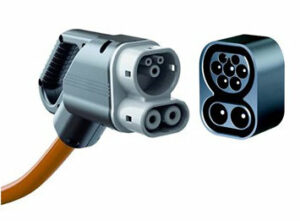
| Charging Point | Max. Power | Avg. Power | Time | Rate |
| CCS (50 kW DC) | 50 kW | 50 kW | 66 min | 250 km/h |
| CCS (175 kW DC) | 151 kW | 105 kW | 32 min | 510 km/h |
| CCS (350 kW DC) | 151 kW | 105 kW | 32 min | 510 km/h |
| Brand | Polestar 2 |
| Model | Long Range Dual Moto |
| Body Style | Liftback Sedan |
| Car Engine | electric |
| Motor power | 300 |
| Maximum Torque, Nm | 660 |
| Battery Energy, kWh | 78.0 |
| Power reserve (NEDC/EPA/WLTP), km | - / - / 395 |
| Level Charging (230/400/DC), hours | - / 8.15 / 0.32 |
| Electrical Acceleration, 0-100 km/h (0-62.1 mph) in sec | 4.7 |
| Top Speed, km/h | 205 |















